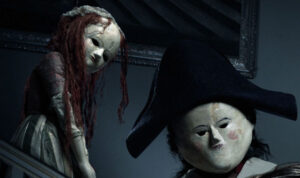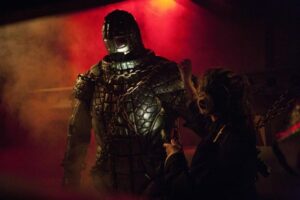Who Psychologies: Mark Gatiss
Guest contributor Mark M analyses Gatiss’ episodes so far.

This article is a meta-analysis of all of the episodes by a particular writer since the revival, looking particularly at how they make their episodes work, make their audience invest in their episodes and how they play with your mind. The subject of this article is Mark Gatiss, who has written six episodes for us so far.
Overarching themes
Throughout the majority of Gatiss’ episodes the setting is the past. In my opinion it works well as it allows Gatiss to focus on his strengths: his characters and the history. It has a positive effect on his audience. Most people have some knowledge of the historical events covered and therefore are immediately invested in the episode. If they aren’t aware of the era of history in the episode, then it is an educational experience for them.
The Unquiet Dead
 This was a very important episode for the show as it was the first of the revived series to be set in the past, so Gatiss had to get it right. Gatiss delivers on all points; he includes one of the most famous writers of all time in Charles Dickens. The Gelth were the perfect monsters for this episode too as it allowed Gatiss to prey on some fundamental fears, something the show is very good at. In this case it is ghosts. His take on this classic scare is sublime, as is his depiction of the haunted funeral home. The characterisation in this episode is one of the best in the new series: Dickens and his desire for information, Gwyneth as an innocent victim, both of the Gelth and her hidden power.
This was a very important episode for the show as it was the first of the revived series to be set in the past, so Gatiss had to get it right. Gatiss delivers on all points; he includes one of the most famous writers of all time in Charles Dickens. The Gelth were the perfect monsters for this episode too as it allowed Gatiss to prey on some fundamental fears, something the show is very good at. In this case it is ghosts. His take on this classic scare is sublime, as is his depiction of the haunted funeral home. The characterisation in this episode is one of the best in the new series: Dickens and his desire for information, Gwyneth as an innocent victim, both of the Gelth and her hidden power.
The Idiot’s Lantern
 History again, and another recognisable figure. This time it’s Queen Elizabeth II and her coronation. The Queen is very well known throughout the world and is quite popular. It follows therefore that as the show begins to grow going into its second series, it makes sense to use the Queen and show the beginning of her reign, again something to maintain the interest of the larger audience.
History again, and another recognisable figure. This time it’s Queen Elizabeth II and her coronation. The Queen is very well known throughout the world and is quite popular. It follows therefore that as the show begins to grow going into its second series, it makes sense to use the Queen and show the beginning of her reign, again something to maintain the interest of the larger audience.
The Wire is a stroke of genius; a savage beast whose hunger cannot be quenched. To make it scarier to the audience, the Wire attacks through the very medium we are watching the episode. It takes a special writing ability to make the audience scared of an object as simple as a TV. Gatiss raises the stakes also by having the companion fall victim to the Wire
Victory of the Daleks
 His most ambitious story yet: World War II, Churchill and the Daleks. This episode sould reverberate well with the older viewers. When Doctor Who first began the world would still have been feeling the impacts of the war, with several fans and fathers of fans having fought in it. How fitting then to bring the Daleks, the Doctor’s most iconic enemy, to the battle. I have already mentioned Gatiss’ characterisation skills and in my opinion Churchill is his best (and someone must agree seeing as he has been back twice).
His most ambitious story yet: World War II, Churchill and the Daleks. This episode sould reverberate well with the older viewers. When Doctor Who first began the world would still have been feeling the impacts of the war, with several fans and fathers of fans having fought in it. How fitting then to bring the Daleks, the Doctor’s most iconic enemy, to the battle. I have already mentioned Gatiss’ characterisation skills and in my opinion Churchill is his best (and someone must agree seeing as he has been back twice).
I have a slight issue for this episode; it appears its quality is slightly affected by the fact the goal of the episode to resurrect a new breed of Dalek. It doesn’t seem to match with Gatiss style of simplicity and small sets. This was also the first time he included something totally historically inaccurate (spitfires in space). Some fans loved this, but not all.
Night Terrors
 This was new territory for Gatiss. His first and thus far, only non-historical episode. However, he still brings his strong traits as a writer. Characterisation is solid as usual, Alex (Daniel Mays) being a particular highlight. Gatiss explores the family dynamic with something simple like a scared child being a problem. Every family household has experienced this, and Gatiss is well aware of the fact. He also brings in one of his own fears, dolls. This gives the episode a more personal feel and involves the audience more. The music accompanying the dolls is also terrifying.
This was new territory for Gatiss. His first and thus far, only non-historical episode. However, he still brings his strong traits as a writer. Characterisation is solid as usual, Alex (Daniel Mays) being a particular highlight. Gatiss explores the family dynamic with something simple like a scared child being a problem. Every family household has experienced this, and Gatiss is well aware of the fact. He also brings in one of his own fears, dolls. This gives the episode a more personal feel and involves the audience more. The music accompanying the dolls is also terrifying.
Cold War
 This story suffers from some of the same issues as Victory of the Daleks: its goal to reintroduce a classic monster overshadowed the entire story. That said, this was still a fantastic episode, Gatiss takes a classic monster, the Ice Warriors, spots their weakness and removes it, making them stronger and scarier. It is worth noting that this was also the first episode of the revival to show a victim’s blood, not a big deal but it raises the stakes, as does the loss of the TARDIS early in the story. The episode had a very claustrophobic feel to it, resulting in edge of the seat viewing.
This story suffers from some of the same issues as Victory of the Daleks: its goal to reintroduce a classic monster overshadowed the entire story. That said, this was still a fantastic episode, Gatiss takes a classic monster, the Ice Warriors, spots their weakness and removes it, making them stronger and scarier. It is worth noting that this was also the first episode of the revival to show a victim’s blood, not a big deal but it raises the stakes, as does the loss of the TARDIS early in the story. The episode had a very claustrophobic feel to it, resulting in edge of the seat viewing.
The Crimson Horror
 In my opinion this is Gatiss’ best episode to date. This episode had it all: the story was well paced, it started with a mystery, and for once there was no sign of the Doctor. This allowed the audience a chance to figure it out themselves, a rare thing in the show. There are also fantastic relatable characters, my favourite being the tragic Ada. Miss Gillyflower is perhaps one of the best villains we have seen. The perfect villain, is one who we don’t hate, one who can also be seen as a victim of circumstances and one who can’t be redeemed, a villain we hate to hate. The inclusion of fan favourites, Jenny, Strax and Vastra, is also a neat trick to draw in the viewer’s intentions.
In my opinion this is Gatiss’ best episode to date. This episode had it all: the story was well paced, it started with a mystery, and for once there was no sign of the Doctor. This allowed the audience a chance to figure it out themselves, a rare thing in the show. There are also fantastic relatable characters, my favourite being the tragic Ada. Miss Gillyflower is perhaps one of the best villains we have seen. The perfect villain, is one who we don’t hate, one who can also be seen as a victim of circumstances and one who can’t be redeemed, a villain we hate to hate. The inclusion of fan favourites, Jenny, Strax and Vastra, is also a neat trick to draw in the viewer’s intentions.
The Future
So what can we expect from Gatiss? The most probable answer is, more of the same. If it isn’t broke, don’t fix it. However, I would enjoy seeing Gatiss try a future setting in one of his episodes. It would be interesting to see how he handles those sort of characters. What is evident though is that he has the ideas to make it work and entertain you, whatever his episode be about. What more can you ask?








